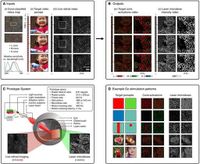A team of scientists at the University of California, Berkeley, has made a groundbreaking claim: they have discovered a new color, dubbed "Olo," that no human has ever seen before. This color was produced through a novel technique that stimulates specific photoreceptors in the retina using laser technology, pushing the boundaries of human visual perception.
The research, published in the journal Science Advances on April 21, 2025, has captivated experts and sparked debates about the nature of color perception. The scientists used a device known as "Oz" to selectively activate the medium-wavelength (M) cones in the retina, which are responsible for detecting green light. By isolating these cones, the researchers aimed to create a color experience that is unattainable through natural light.
In their experiment, the team mapped the retinas of five participants to locate their M cones accurately. They then employed adaptive optics optical coherence tomography (AO-OCT) to ensure precise targeting. The volunteers were positioned in front of a small square target while the lasers were fired at their M cones, resulting in a visual experience described as a "patch of color" about twice the size of a full moon.
The hue named "Olo" is characterized as a highly saturated blue-green, although researchers caution that it cannot be replicated by any standard screen or pigment. According to Professor Ren Ng, a co-author of the study, "The color we see on a monitor pales by comparison." He explained that those who witnessed Olo were unable to match it with any existing color on a digital color wheel, suggesting it exists beyond the known spectrum of human perception.
Participants described Olo as "pure green plus something extra" or simply stated, "I’ve never seen anything like it." Ng elaborated on the significance of the discovery by comparing it to a hypothetical scenario: "Let’s say you go around your whole life and you see only pink, baby pink, a pastel pink, and then one day you go to the office and someone's wearing a shirt, and it's the most intense baby pink you've ever seen, and they say it's a new color and we call it red." This analogy highlights the profound nature of experiencing a color that has never been seen before.
Despite the excitement surrounding this discovery, not all experts are convinced that Olo represents a truly new color. Some skeptics argue that it is simply an extreme version of green, as it still falls within the greenish territory. John Barbur, a vision scientist at City St George’s University, London, stated, "It’s a more saturated green that can only be produced in a subject with normal red-green chromatic mechanism when the only input comes from M cones." This perspective raises questions about the definition of color and whether it is determined by the wavelength of light or the subjective experience in our minds.
The implications of this research extend beyond the realm of color perception. The team believes that the Oz technique could pave the way for advancements in studying and treating color blindness and other ocular diseases. By selectively activating certain cone types, scientists may be able to simulate conditions for individuals lacking specific cones, offering new insights and potential therapies.
Moreover, this discovery aligns with past hypotheses in the field of evolutionary biology. Richard Dawkins had speculated about the existence of a "super green" color if scientists could ever manage to isolate just the green cones. Ng noted, "It’s satisfying to see speculation become reality, as the research team effectively turned theory into practice."
As the scientific community continues to debate the nature of Olo, the research raises profound questions about the limits of human perception. If the brain can experience colors beyond the natural input range, could there be other colors waiting to be discovered? Researchers are now considering the possibility of creating "ultra-red" or "ultra-blue" experiences by targeting the other cone types with similar laser techniques.
While the prospect of seeing Olo on a screen remains unlikely—given that current technology blends RGB signals—it opens up avenues for future exploration in both artistic expression and medical applications. The ability to create entirely new visual sensations by hacking the retina could revolutionize how we understand vision and perception.
In conclusion, the discovery of Olo serves as a reminder of the hidden potential within our senses. It challenges the notion that we have fully explored the limits of human experience and suggests that reality may still hold many secrets waiting to be unveiled through scientific inquiry. As researchers continue to push the frontiers of perception, who knows what other remarkable discoveries lie ahead?








